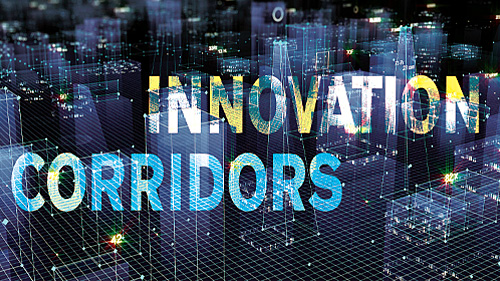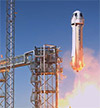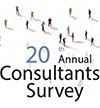Innovation Corridors Have Economic Assets Driving Business Growth
By actively putting together the resources needed for innovative companies to survive and thrive, innovation districts and corridors have found a recipe for success.
Q4 2021

But just as you can find more and more cutting-edge restaurants and exceptional craft breweries in sometimes surprising places beyond the most obvious locales, the innovation-based recipe for success is being served up in smaller communities, too, far beyond the places that may first come to mind. When it comes to building an innovation corridor or innovation district, the traditional addresses don’t have a monopoly on brains and forward-thinking.
“New Geography of Innovation”
The Brookings Institution a few years ago studied what it called the “new geography of innovation,” and for their purposes, the researchers defined innovation districts as “geographic areas where leading-edge anchor institutions and companies cluster and connect with startups, business incubators, and accelerators. They are also physically compact, transit-accessible, and technically wired, and offer mixed-use housing, office, and retail.”
The institution’s research found that there’s plenty going on in such obvious places as Research Triangle Park, Boston, and San Francisco. But it also pinpointed emerging districts near anchor institutions in downtowns and midtowns of such places as Atlanta, Baltimore, Brooklyn, Buffalo, Cambridge, Chicago, Cleveland, Detroit, Houston, Philadelphia, Pittsburgh, Portland, Providence, St. Louis, and San Diego.
Even that list is just a sampling of the locations that are actively trying to put the pieces together so that innovative companies can thrive. Innovation districts, wherever they sprout, can “provide a strong foundation for the creation and expansion of firms and jobs by helping companies, entrepreneurs, universities, researchers, and investors — across sectors and disciplines — co-invent and co-produce new discoveries for the market,” according to Brookings. What’s more, they can counteract some of the forces of social inequality and urban sprawl.
One way to identify innovation corridors is to measure the outcomes. Perhaps the most recognizable identifier of innovation is a patent, so when 24/7 Wall St. set out to find the country’s most innovative cities, it tracked the number of patents granted in a single year, per 100,000 residents. The study found a strong correlation between patent concentration and the presence of major research institutions as well as big companies involved in science and technology.
A fifth of the cities were in California, including #1 San Jose-Sunnyvale-Santa Clara. It’s no surprise given the presence of Silicon Valley and such players as Apple, Google, and the newly renamed Meta. New York and Colorado had three cities each, and North Carolina and Washington State had two. You probably would not be surprised to find a place like Rochester, Minnesota, on the list, once you consider the fact that the Mayo Clinic is there. Again, the recipe for success was a combination of research institutions and big corporate players in research-driven fields.
Stirring Together the Ingredients
Every innovation corridor has its own distinct elements, ingredients in its recipe for success that set it apart. Yet there are some overall characteristics that underly this model of economic development and growth. The Brookings research boils it down into three key areas: economic assets, physical assets, and networking assets.
The economic assets include the people and institutions actually driving innovation. That can include research and medical institutions, big companies and startups, the experts in various fields, and the entrepreneurs who bring new ideas to market.
When it comes to building an innovation corridor or district, the traditional addresses don’t have a monopoly on brains and forward-thinking. For example, Corvallis, Oregon, #10 on the 24/7 Wall St. list of innovative cities, gets a powerful boost from the presence of Oregon State University. Having Caterpillar Inc. in town helps Peoria, Illinois, listed as #22, as does the Peoria NEXT Innovation Center that connects Caterpillar and others with institutions such as Bradley University. Meanwhile, #20 is Columbus, Indiana, which may be 50 miles from the nearest big research university but is the headquarters of Cummins Inc., an innovative Fortune 500 player in engines and power generation.
These innovation drivers are key ingredients, but just as a loaf of bread needs yeast, these ingredients need “innovation cultivators” to help them rise to the occasion and thrive. That could include incubators and accelerators, tech transfer offices, and job training organizations. And because innovation is so dependent upon people, it’s vital to have neighborhood-building amenities that make the area attractive to those people, from grocery stores to coffeeshops to medical offices to dog parks.
Physical assets, according to Brookings, may be public or private. They can include roads and parks, as well as homes for the people and buildings for the businesses and institutions. Physical assets need to be digitally accessible, now more than ever.
And finally, to take the recipe metaphor one step further, these ingredients need to be mixed together. That’s where networking assets come in — and, in this case, we’re talking about people networking. This is how information is shared, how ideas come together, how collaboration happens. The most advanced university won’t support local innovation if its brains don’t network with the right elements of the business world. The most ambitious local startup might miss the best opportunities if it doesn’t network with nearby subject-matter experts. These connections are what turn regular cities and regions into innovation corridors.
Take Ann Arbor, Michigan, as an example. 24/7 Wall St. had it sixth on the list of most innovative cities, not a big surprise given the presence of the University of Michigan. But it also has Ann Arbor SPARK, with its stated goal of “cultivating a network of business and manufacturing excellence.”
Making Innovation Connections
The greater Phoenix area is a good example of how innovation can be at the center of economic development, with the help of local institutions. Indeed, Arizona State University has established seven Innovation Zones to help companies connect their dreams and goals with the resources of the university, offering access to a diverse pipeline of student talent as well as staff and faculty at a leading research institution. Also valuable, of course, is the ability to hire new grads with innovation-oriented educational backgrounds — and indeed, more than half of the university’s graduates begin their careers in-state.
The university offers an online zone selector to help companies figure out the most ideal spot. Innovation Zones are located at different addresses across the region, each with its own areas of specialization. They include the Phoenix Biomedical Campus, the ASU Polytechnic campus, the ASU Scottsdale Innovation Center, the ASU Research Park, and the Novus Innovation Corridor, which is located on the university’s Tempe campus.
Novus, for example, encompasses more than 350 acres and includes more than 10 million square feet of opportunity. Like many innovation districts, it blends technology uses with retail services and is punctuated by parks, bike paths, and sidewalks for walkability.
Local economic development and educational leaders are also cooking up an innovation recipe in Norfolk, Virginia. The area they’ve identified as the Norfolk Innovation Corridor stretches from Old Dominion University to Norfolk State University and includes the Eastern Virginia Medical School. It’s an area with resources to support growth of technology companies and, at the same time, attract a talented and diverse workforce.
Beyond the people connections with academic experts and technology workers, companies locating in the Norfolk Innovation Corridor can tap into a variety of economic incentives. Examples include abatement of the Business, Professional and Occupational License taxes and a 50 percent reduction in planning, zoning, and building permit fees.
Because innovation is so dependent upon people, it’s vital to have neighborhood-building amenities that make the area attractive to those people. Also in Virginia, the Roanoke Innovation Corridor is a place where leading biomedical researchers, students, care providers, and businesses thrive through collaboration. The corridor offers brand new interdisciplinary training and research facilities through the Fralin Biomedical Research Institute and Carilion Clinic, in addition to strong academic and economic partnerships between Carilion Clinic, Virginia Tech, Virginia Western Community College, Jefferson College of Health Sciences at Carilion Clinic, and Radford University.
Consider Lexington, Kentucky, as another prime example of innovation-focused development opportunities that are happening in areas outside what one used to think of as the most obvious innovation hubs. The presence of the University of Kentucky provides valuable access to talented partners, and companies that make a connection to the university can set up shop within Coldstream Research Campus. It’s zoned for R&D, advanced manufacturing, and office use, and it’s tied into inquiring university minds.
Innovation-oriented businesses also might seek an address at the Blazer Parkway Technology Center in Lexington. Its Tech Center and Data Center buildings feature such innovation necessities as redundant power and fiber, along with flexible, easy-to-configure wall panels that can adapt a facility layout as needs change. These and other addresses in this innovation-oriented corridor are located just an hour from the bigger cities of Louisville and Cincinnati, which are innovation hubs in their own right.
The Texas Innovation Corridor similarly has its own place on the map between two other prime innovation dots: Austin and San Antonio. It claims its own innovation ecosystem, with a pair of counties that together have a patents-per-capita ratio that’s 11 times the state average and nine times the U.S. norm.
Having Texas State University in San Marcos helps tremendously, given its strong research in such areas as materials science, nanotechnology, life sciences, and computer science. The university’s STAR Park — STAR is short for Science, Technology and Advanced Research — is a technology incubator for startup and early-stage businesses, offering research connections and access to such things as wet labs and clean space. There are also numerous co-working and collaboration spaces across the Texas Innovation Corridor, as well as the Texas State Center for Innovation and Entrepreneurship.
And Hartford, Conn., has dubbed itself as an Innovation Destination. The city’s initiative aims to facilitate connections with its entrepreneurial community and support startups and second-stage companies throughout the Hartford region.
Varying Innovation Approaches
The Brookings researchers who have explored the growth in innovation districts have identified a number of different ways these areas can develop and be organized. One common way to go is known as “anchor plus,” which is a large-scale mixed-use development that has a major anchor institution surrounded by related spinoffs and entrepreneurs. For example, Kendall Square in Cambridge, Massachusetts, is powered by such institutions as nearby Massachusetts Institute of Technology, Massachusetts General Hospital, and Harvard’s medical school. It has resulted in extraordinary accomplishments among nearby life sciences and information technology companies.
Philadelphia’s University City district has had similar success. Its anchors include the University of Pennsylvania, Drexel University, and the University City Science Center, and its impact has been not only business success, but also economic revitalization. The Houston Innovation Corridor, likewise, has had powerful economic and social benefits, creating fruitful innovation partnerships and transforming neighborhoods. Its anchors include Texas Medical Center and Rice University. Similar anchor-plus developments can be found all over — in St. Louis, Pittsburgh, Atlanta, and Detroit, to name a few. As Brookings notes, “Virtually every major city in the United States has an ‘anchor-plus’ play.”
Another approach is the “re-imagined urban area” model, which typically springs up in an industrial or warehouse district near a historic waterfront. Brookings cites such examples as Boston’s South Waterfront, Mission Bay in San Francisco, the South Lake Union area of Seattle, and the Brooklyn Navy Yard in New York City.
As Brookings has concluded, the innovation district is a powerful path to mitigating many of the country’s longstanding challenges, from economic hardship to inequality. The other primary model is known as the “urbanized science park,” and one of the best-known innovation corridors in the country — Research Triangle Park in North Carolina — fits into this mold. Its history goes way back to the middle of the last century, when the state was in economic decline and local leaders sought to better retain university graduates and build new vitality. A group of governments, universities, and business interests partnered to get the ball rolling in 1959.
Research Triangle Park is considered the country’s largest research park, and it’s anchored by North Carolina State University, Duke University, and University of North Carolina at Chapel Hill. Firms such as IBM and Burroughs-Wellcome located R&D facilities in the area early on, and the word spread that it was a great place for emerging research and technology companies. By the 1990s, the region encompassing Raleigh, Durham, and Chapel Hill was well-known as “The Research Triangle.” A state that was struggling in the 1950s now is among the top three states in bioscience employment, and it’s a leader in important fields such as vaccine research and manufacturing.
That kind of success, of course, inspired others. Just a few examples include University Research Park at the University of Wisconsin-Madison, University of Virginia Research Park in Charlottesville, and the University of Arizona Tech Park in Tucson. These kinds of innovation districts typically have strong ties to major research universities, though not all such developments are in big urban areas.
An example of a development that sprouted away from a big city is Purdue Research Park. Much of its work in commercialization and economic development happens in the small university town of West Lafayette, Indiana, in a 725-acre technology park that’s home to more than 100 technology companies. Since its founding in the 1990s, Purdue Research Park has added locations elsewhere in Indiana.
Countless other developments across the country fit into one of these formats and can be considered innovation districts or corridors. With so much future prosperity likely to be linked to technology development, that’s a good thing. As Brookings has concluded, the innovation district is a powerful path to mitigating many of the country’s longstanding challenges, from economic hardship to inequality: “Innovation districts have the unique potential to spur productive, inclusive, and sustainable economic development.”
Project Announcements
Australia-Based Aquatic Leisure Technologies Group Plans Opp, Alabama, Manufacturing Operations
12/11/2025
Teradyne Plans Wixom, Michigan, Robotics Operations
12/11/2025
Robinson Plans Altoona, Iowa, Manufacturing Operations
12/11/2025
BioTouch Expands Columbus, Georgia, Operations
12/11/2025
Natrion Plans Erie County, New York, Battery Components Operations
12/11/2025
Czech-Based GZ PrintPak Expands Mount Pleasant, Wisconsin, Manufacturing Operations
12/11/2025
Most Read
-
The Workforce Bottleneck in America’s Manufacturing Revival
Q4 2025
-
Rethinking Local Governments Through Consolidation and Choice
Q3 2025
-
First Person: Filter King’s Expansion Playbook
Q3 2025
-
Lead with Facts, Land the Deal
Q3 2025
-
How Canada Stays Competitive
Q3 2025
-
Investors Seek Shelter in Food-Focused Real Estate
Q3 2025
-
America’s Aerospace Reboot
Q3 2025



